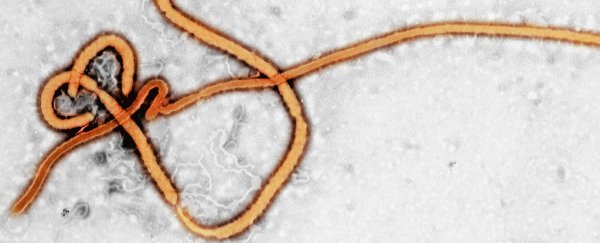This time last month, national authorities in the African nation of Guinea declared they were dealing with an outbreak of Ebola deep in its rural southern region of Nzérékoré.
With the outbreak currently consisting of 14 confirmed cases and four suspected, the World Health Organization is employing a range of protective and tracing measures to contain the virus's spread.
Suspicions over the source of the cluster have so far focused on a 51-year-old nurse who died at the end of January, having sought help from both medical facilities and a traditional healer after a bout of high fever, vomiting, weakness, and diarrhea.
After first being diagnosed with typhoid and later malaria, it now appears her illness was caused by the far more deadly Zaire ebolavirus, a pathogen so deadly that at least five of the cases in the latest outbreak have already succumbed to its effects.
It's a tragic outcome for the woman and her family, who made up six of the the first seven known cases identified – the last being the healer she turned to for help.
Yet the consequences of the virus's unmitigated spread could be far worse. From late 2013 until 2016, the pathogen raged across the nations of Guinea, Liberia, and Sierra Leone in an outbreak that saw roughly 40 percent of the 28,610 infected die.
Smaller outbreaks have arisen since in the Democratic Republic of the Congo, but researchers now have reason to doubt that this most recent emergence is connected to any of those outbreaks, and may even have been lurking inside a carrier in Guinea for the past five years or more.
A genomic analysis of samples of the virus taken from four of the patients was carried out by the Guinea Center for Research and Training in Infectious Diseases (CERFIG) and the National Hemorrhagic Fever Laboratory, revealing they belonged to the West African epidemic's highly virulent Makona strain.
This conclusion was backed up by a second analysis on three samples conducted by the WHO reference laboratory at Senegal's Pasteur Institute, which compared the genes of these most recent virus specimens with 1,063 genomes from the 2013-2016 West Africa outbreak.
Taken together, the results tell a rather shocking, if rather speculative story, suggesting the nurse's husband may have quietly hosted the virus in his body years longer than anybody would have previously thought possible.
In general, it takes roughly a week or so for the Zaire ebolavirus to start causing problems in the human body, which commences with targeting a variety of immune cells to open the way to a rapid spread.
White cells called macrophages eventually catch up with the onslaught, gobbling up the cells in all-out war. The consequences lead to capillaries leaking and clots settling into vessels, putting whole organ systems at risk of collapse.
It's during this period that infected secretions of bodily fluids can most easily pass the virus on.
Studies on the infectiousness of Ebola tend to use the presence of these 'wet symptoms' as a way of defining an average infectious period, which is typically around five to 15 days.
Yet there are signs the virus might hang around inside the body for far longer, with its RNA detectable in urine after a month, sweat after about 40 days, and in semen more than a year.
Even if these examples reflect a talent for lying dormant months after recovery, a whole five years is a shocking stretch.
Nonetheless, the virus particles analyzed in this new outbreak have a great deal in common with the West Africa epidemic, and evidence suggests it was most likely not picked up from a local animal reservoir.
It's not impossible that the virus might have bounced from one human host to another during the past five years, but researchers from the Pasteur Institute aren't viewing it as probable either.
"This number of substitutions is far less than what would be expected during sustained human-to-human transmission," the team notes in its report.
Even as a rare case, the finding challenges thoughts on how such outbreaks might start, and how to effectively communicate health and safety measures in affected communities.
Victims of Ebola already face heavy stigma in many African cultures, not just from others in their community but significantly in their own impression of self-worth.
While the message that Ebola in some instances remains transmissible many years after infection could help save lives, it's a statement that could also come with a heavy price.
This research was published on virological.org here, here, and here.
